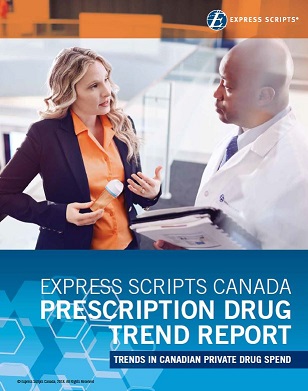The Rising Costs and Challenges of Managing Benefit Plans
The following was previously published in Canadian HR Reporter.
Affordable benefit plans are an essential incentive for employees, but currently pose challenges for companies as costs continue to rise and health claims and prescription drug requirements become more complex.
As the population ages, the challenge for plan sponsors to balance the health of their members and the cost of offering competitive benefit and prescription drug coverage will continue to increase. According to the 2017 Prescription Drug Trend Report by Express Scripts Canada, 20% of employees are accounting for almost 80% of prescription drug costs for employer-offered benefit plans in Canada. This imbalance raises complications in terms of productivity, plan costs and the overall health of these individuals.
Communication between employers and their employees is key to ensuring proper usage of the benefit plans. But first, it’s essential to understand the financial impact and productivity loss that come from non-adherence.
Read: High-cost drugs put valuable employee benefit at risk
The Prescription Drug Trend Report found that the people who need their medications the most – the employees who account for 80% of total drug costs – are also the people who are the least adherent in taking their medications properly. HR professionals now more than ever need to be aware of additional support for this group of employees, to help manage their conditions and treatments so that they are adherent. Companies should work with benefit plan providers that have active pharmacy services to help tailor programs to address some of the most common chronic conditions in order to reduce absenteeism, increase productivity and reduce risk of these employees going on disability leave. HR professionals and employers must also be aware that sometimes these claims are made by employees on behalf of their dependants or spouse. This requires education and open communication to ensure everyone covered in the benefit plan is properly adhering to their medications and are made aware of programs and treatments available to them.

When only a small group is making the majority of benefit claims, companies are challenged with how to offset costs.
“The Drug Trend Report found that average annual drug spending for these claimants is 15 times that of other employees, to break it down further, the top 20% of claimants represent 79% of plan spending, with an average cost per claimant of $3,386,” says John Herbert, Director of Strategy, Product Development and Clinical services with Express Scripts Canada.
When employers react to increases in group benefit plan costs by choosing to reduce coverage, it negatively affects morale and employee engagement. It also becomes harder for companies to continue to remain competitive and attract top talent. Employees who do not submit many claims feel it is unfair that they need to be penalized by paying more in premiums or having reduced coverage.
It is essential for employers to better understand the needs of employees who are high-cost claimants and concentrate efforts on providing them with timely support to manage their condition and drug therapy. Most group insurers now also offer health and wellness apps and tools to further support the employers’ efforts in helping employees live healthier lives. Providing encouragement to this group of patients is the best way to control drug plan costs overall. In providing accessible and comprehensible plans, the outcome is better health and a better system for managing the impact of costs on all employees.
Read: A drug plan that saves you money and improves your health? Yes. Read the case study.
While chronic conditions such as diabetes, high cholesterol and asthma continue to be prevalent illnesses in the workplace and account for high prescription drug spending, mental health issues such as depression and anxiety are also impacting the workplace with greater frequency. According to statistics from the Centre for Addiction and Mental Health (CAMH) at least half a million Canadians are unable to work due to mental health problems in any given week. The Prescription Drug Trend Report found that spending on prescription drugs that help treat depression also increased. The report indicates that sadly, cancer diagnosis is also on the rise and has been the leading cause of death in Canada for the last 10 years and ranked #7 by overall spending in 2017, up from #10 in 2016. The performance of employees who suffer from these conditions can suffer because naturally, they have good days and bad days while they are being treated. Employees would like to work and contribute on the days that they feel good, but this can be unpredictable and employers also do not want to be liable for an employee who works during treatment. This can be challenging to balance for employers.
Providing targeted, timely support to help members make decisions that optimize cost and care is essential. This can be achieved through several methods including aligning member and plan sponsor interests through intelligent design solutions, providing incentives for optimizing therapy, identifying opportunities to capture the attention of employees at the right time to influence optimal treatment decisions, helping employees conveniently implement optimal decisions and most importantly, empowering and engaging plan members/employees.
Read: Providing targeted support to the 20% of benefit plan members who need help
Companies can help control costs while making sure their employees are healthy by taking a holistic approach to wellness. This ensures chronic conditions are caught and treated early for best outcomes. Plans need to be managed comprehensively and members with high-cost chronic conditions require targeted support. Urgent action to control costs and close gaps in care is essential for any company, and adopting comprehensively managed plans makes it possible for plan sponsors to improve health outcomes for their employees at a cost that they can afford.
Stéphanie Myner-Nham is the Director of Human Resources and Corporate Services with Express Scripts Canada.